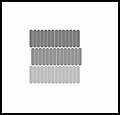Satin stitch

In
In order to maintain a smooth edge, shapes can be outlined with back, split or chain stitch before the entire shape including the outline is covered with satin stitch. In traditional practice, satin stitch is employed to fill an area without the presence of an outline, resulting in smooth shapes and even lines created by the stitching.[2]
Machine-made satin stitch is often used to outline and attach
Geography
The satin stitch is a common form of needlework traditions worldwide; it is notable in

China
Satin stitch is one of the two main types of Chinese embroidery stitches along with the Pekin knots.[6] It is the most frequently used form of stitches in Chinese embroidery.[4] From the ancient times to the Tang dynasty, the chain stitches were typically used in embroidery.[7] However other forms of embroidery techniques existed including satin stitches which dates as early as the Han dynasty.[8][9]
The use of satin stitches became more frequent in the late Tang dynasty to the early Song dynasty.[7] During the Tang dynasty, figural imagery, which was partially influenced by the growth of Buddhist imagery, first appeared; this contributed to the decline of chain stitches as satin stitches could provide better render scenes of Buddhist donor figures.[10] Satin stitches then became the popular embroidery technique later on.[7]
Indian Subcontinent
Satin stitch used in Kashmir is a variation of the Chinese Satin stitch which originated from China.[11]
Variants
Variants of the satin stitch include:
- Bourdon stitch - a tightly spaced, decorative stitch typically used for monograms and decorative purposes.[12][13]
- Brick stitch, in which alternate rows of satin stitches are offset by half the stitch length. Worked in several related colors, brick stitch allows stepped shading. (Brick stitch is also the name of a beadwork technique.)
- Encroaching satin stitch, in which the top of each row of stitches is set between the bottom of the stitches on the previous row.
- Long-and-short stitch, used for fine shading; in the first row of satin stitches, every other stitch is half the length of its neighbors. Subsequent rows in related colors are all of the same length.[14]
- Padded satin stitch, in which shapes are filled with rows of small running stitches which are then covered with satin stitches.[15]
Thread
Satin stitch is frequently made with embroidery thread, which has less twist than standard sewing thread. This gives a more uniform effect, with the individual threads' filaments merging.
While good sewing threads produce acceptable satin stitch, low quality threads usually do not sit straight, and produce an uneven result. The colour of each thread usually does not matter.
Stitch gallery
-
Satin stitch
-
Bourdon stitch
-
Brick stitch
-
Encroaching satin stitch
-
Long-and-short stitch
See also
Notes
- ISBN 0-89577-059-8, p. 48
- ^ "How to Work Satin Stitch in Hand Embroidery". The Spruce Crafts. Retrieved 6 February 2024.
- ^ Complete Guide to Needlework, p. 196-197
- ^ OCLC 231411503.
- ^ OCLC 812915249.
- OCLC 869091722.
- ^ S2CID 116592344.
- OCLC 49797139.
- ^ Langford, Heather (2009). The textiles of the Han Dynasty & their relationship with society (Thesis thesis).
- OCLC 1121420666.)
{{cite book}}: CS1 maint: location missing publisher (link - ISBN 9788123022895.
- ISBN 9788183242059.
- ISBN 9781449408404.
- ^ Christie, Grace (Mrs. Archibald H.): Embroidery and Tapestry Weaving, London, John Hogg, 1912, Chapter V.
- ^ Complete Guide to Needlework, p. 49
References
- Caulfield, S.F.A., and B.C. Saward, The Dictionary of Needlework, 1885.
- Christie, Grace (Mrs. Archibald H.): Embroidery and Tapestry Weaving, London, John Hogg, 1912; e-text at Project Gutenberg
- Reader's Digest. Complete Guide to Needlework. The Reader's Digest Association, Inc. (March 1992). ISBN 0-89577-059-8








